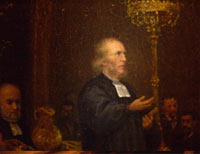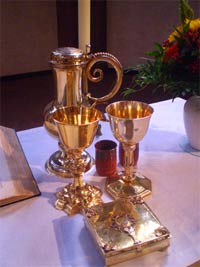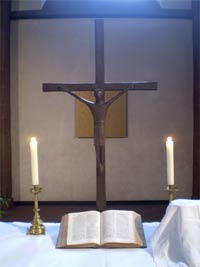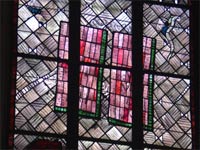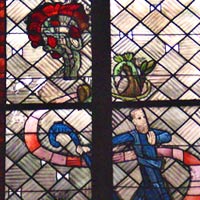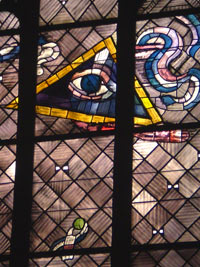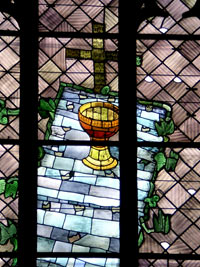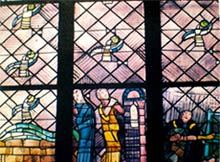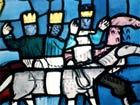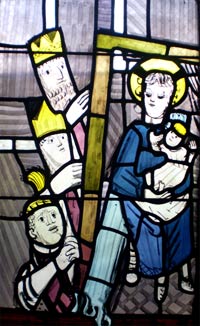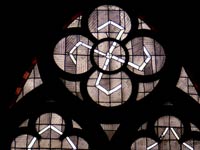The Three Kings Church in Frankfurt-Sachsenhausen
GUIDE TO THE THREE KINGS CHURCH
CONTENTS:
A short history
|
1340 Dedication of a Gothic hospital chapel, donated by Heile Dymar, a citizen of Sachsenhausen. Origin of the Main Festival, the oldest festival of Frankfurt, which is still celebrated annually 1452 Chapel becomes a parochial church 1531 The Three Kings Church joins the Lutheran Reformation with the official installation of its first Protestant Pastor, Peter Chomberg 1690 Baroque transformation of the church 1875 Demolition because of age-related damage and construction of the present neo-Gothic hall church by the cathedral master builder J. F. v. Denzinger 1881 Dedication of the present Three Kings Church 1934 The Three Kings Church joins the “Bekennende Kirche” (Confessional Church), a movement which opposed Nazi ideology 1945 Repair after war damage 1956 Installation of stained glass windows by Charles Crodel 1961 Installation of the Schuke-Organ, especially suited for baroque music |
|
Two renowned church musicians, who dedicated themselves to the music of J. S. Bach, served at this church: |
East-West-Orientation
West
This church is built according to Christian tradition. The entrance is in the West, so that the visitor upon entering the church turns his back to the West: the direction of the setting sun and the coming night, indicative of the powers of darkness, the blackness of death and the nightfall of the world which will pass away.
For this reason, the tower of the church, which is like a fortress, is on the west side. It represents the power of God to defend His people against death, devil and darkness („A Mighty Fortress is our God“). Jesus said to His disciples, when describing the Church: „The gates of hell („Hades“= the realm of death) shall not prevail against it“. The fortress-like tower of the church stands for this power, which is infinitely stronger than death and evil.
East
The congregation celebrates worship looking toward the East: the direction of the rising sun, a symbol for the resurrection of Christ, which occurred in the dawn and was itself the sunrise of a new creation. The morning sun also indicates the rising „Sun of Righteousness“ referred to in the last book of the Old Testament which was applied to Christ. This eastward orientation is a reminder that Christians worship on Sundays in order to celebrate the resurrection.
The Ten commandments in the book of Exodus prescribe Saturday (the Sabbath) as the holy day of rest. But the first Easter Sunday was regarded as the decisive turning point in the history of mankind. The resurrection defined God as the One who has defeated death and thus demonstrated that He is mightier than all regimes of terror and tyranny, which derive their power from their ability to kill. He who can bring the dead to life is mightier than all the murderers in mankind’s history. Worship on Sunday witnesses to this decisive moment of victory. Sunday worship gives Christians the strength to live out their faith, despite all adversity, and wait for the day on which the Easter victory will be consummated. Every Sunday worship service is an Easter event.
Entrance
In the entrance area, before entering the church, there are two angels (created by Charles Crodel): a joyful (red angel) and a sorrowing (blue angel).
These angels indicate that Christian worship is a place where earth and heaven come together. The sorrow and grief that we bring into the church, which involves our estrangement from God, is carried into the heavenly world - especially when we sing at the beginning of the service „Lord, have mercy upon us.“ The blue, grieving angel indicates that human sorrow is felt in heaven.
The reconciliation with God, which brings joy and peace, is also proclaimed at the beginning of the service when we sing: „Glory to God in the highest“. The red angel indicates the joy in heaven, when human beings repent and recieve grace.
The Alms Box
As you enter the church you will pass under a wooden sign which advertizes the General Alms Box of 1531, the name of a foundation, established on March 15, 1531, which still exists and which collects and distributes money for the poor and needy. The Reformation provided a decisive impulse for the establishment of this institution.
The message on the sign says “Gebt den Hußarmen (Hausarmen) umb Gottes willen in gemeynen Kasten 1531” (“Give for the local poor people for the sake of God to the general box, 1531). The language on the sign indicates that the charity distributed by this foundation was restricted to citizens of Frankfurt. This restriction was necessary, because wandering beggars would have overwhelmed the resources of this charity fund.
Those wanting to receive help were required to wear the official eagle-insignia of Frankfurt on their coats. 310 insignias were distributed in Frankfurt and Sachsenhausen in 1531.
Each church in Frankfurt had its own Alms Box sign. The sign in this church is the only one which has survived.
In front of the Altar
Eight-Sided Baptismal Font
At the front of the church on the left side stands the baptismal font. The eight corners stand for the so-called "Eighth Day of Creation". According to the account of Creation at the beginning of the Bible, the first day of the week is the day we call Sunday and the Creation was completed on the seventh day, the Sabbath. Since the resurrection occured on a Sunday, a tradition arose which called this first Easter Day the Eighth Day of Creation. This formulation conveys the message that the resurrection was not merely a personal event of Christ, but that this Easter victory has cosmic significance as the dawn of a new creation. The wording „Eighth Day of Creation“ announces that the resurrection will ultimately encompass everything and recreate all of reality. Every person who is baptized becomes „immersed“ in the resurrection and the new creation.
The dedication picture
To the left of the baptismal font and under the balcony is a painting depicting the dedication of this present Three Kings church on May 8, 1881. This painting shows the church before the destruction caused by bombing in the Second World War. It shows that the baptismal font was originally in the middle, directly in front of the altar, and the original pulpit was closer to the altar. Behind altar and pulpit is an open door showing people standing in the sacristy. These people seem to be waiting. Are they to be baptized, confirmed or married – and in this way contribute to the dedication of the church?
The pastor standing in front of the altar is Dr. Johann Jacob Krebs, who was the pastor of this church from 1857 until 1902. In his sermon on the day of dedication, Krebs said: “If a different Gospel were to be preached here, which is actually no Gospel, but a work of man and man’s own wisdom, if people were to keep quiet about it, these stones would cry out.” Krebs refered to this church as a “sermon in stone…whose lines point heavenward, signifying the divine home, the eternal source of the Word of Christ, from which our sermons are derived.”
^ to the top of the pageThe altar: focal point of Holy Communion
An altar in a Lutheran church is a table on which the elements of Holy Communion, bread and wine, are consecrated. In this church the Eucharist is celebrated every Sunday. Holy Communion is also an Easter celebration, since bread and wine represent the living presence of the crucified and risen Christ. We Lutherans speak of the „real presence" of Jesus Christ, „in, with and under the elements of bread and wine" when we celebrate this sacrament.
A sacrament is an event which Christ himself instituted, which conveys grace through visible signs in connection with a spoken word. Protestants recognize two sacraments: baptism and and the Lord’s Supper.
However, symbols can have more than one meaning. A further image which a stone altar conveys is the empty slab of the tomb of Christ – a further reminder of the resurrection. On Good Friday the altar in many churches is stripped of all cloths; the Bible, the candles and the cross are removed. This naked altar is a reminder of the nakedness of Christ when he died (Crucifixion victims were stripped of all clothing).
(On Good Friday in this church only the cloth which hangs in front of the altar is removed; there are no flowers on the altar and the candles are not lit: in this way the congregation participates in the sorrow of Jesus’ death.)
Altar: candles
Altar candles are invariably white, the „color“ of light, because they represent Christ, the Light of the World. There are two, because Jesus Christ is „true God and true man“. Another symbolism which can be seen in these two candles is the light of the Word of God in the Bible, which consists of two parts: Old and New Testament.
Altar: cross
The central point of every altar is the cross, because the cross is the focal point of Christian faith. The cross is the fulfillment of the Incarnation, the Mystery of God becoming man, which is celebrated at Christmas. The Incarnation was initiated in Bethlehem, but the union between God and humanity in the person of Jesus found its culmination on the cross, where the final gap between God and mankind was bridged, when Jesus died our death. This death on the cross has brought comfort to literally millions of people, who see in this event the revelation that God remains with us intimately in all that happens to us. Since God is with us from birth to death, and even beyond the grave, we have ultimately nothing to fear, because we are with God, now and forever.
Altar: flowers
Flowers are not simply decoration. There is no single explanation as to why flowers occur on every altar; symbolism is invariably multidimensional. Flowers can be seen as a reminder of the paradise garden mentioned at the beginning of the Bible. Mankind was created for paradise, and the content of paradise is intimate fellowship with God. The flowers are a token that the goal of life is paradise-like communion with God.
This symbolism is perhaps as old as the Bible. Jesus was buried in a garden - one grave among many – which means that at the time of Jesus cemetaries could also be gardens. The Evangelist John refers to this garden in which Jesus was buried and describes how Mary Magdalene mistook the resurrected Jesus for the gardener, which was the first occupation of the first man, Adam. John is reminding his readers of the paradise garden and presenting Jesus as the new Adam in a new garden, the beginning of a new humanity.
The early Christians used the graves of martyrs as focal points for their worship, celebrating the resurrection at grave sites. The tradition of putting flowers on graves, which served as altars, could perhaps have started at this time.
^ to the top of the pageBehind the altar
The three paintings of the artist Petra Falk, installed 1994, which have the appearance of metal plates, signify the Trinity: God the Father, God the Son, God the Holy Spirit.
- In the middle is gold, which represents God the Father,”who alone has immortality” (1. Tim. 6, 16). Gold cannot rust and thus is an illustration of immortality.
- The copper looks like earth, which is the color of mortality. “You are earth, and to earth you shall return.” (Genesis 3: 19) This plate stands for God the Son who became man and took upon Himself our mortal humanity.
- Silver conveys the message that God cannot be grasped. It is a reminder of wind as a symbol of the Holy Spirit: “The wind blows where it wills and you hear the sound of it, but you do not know whence it comes or where it goes.” (John 3:8)
These plates do not contain pictures, reflecting the Biblical commandment forbidding pictures of God.
But God gave us a picture of Himself in Jesus; “the image of the invisible God” (Colossians 1:15). It is thus appropriate that the crucifix on the altar stands in front of the gold plate, a reminder that the invisible God has revealed Himself in the crucifixion.
Windows of Charles Crodel (installed 1956)
East windows
The five eastern windows display the 5 parts of Martin Luther’s Catechism (an explanation of basic Christian faith in question and answer form).
From left to right: Ten Commandments, Baptism, Apostles Creed (center), Holy Communion, Lord’s Prayer.
This confessional theme was chosen specifically for this church because the original Three Kings Church was the first in Frankfurt to officially confess to the Lutheran Reformation in the year 1531; and in 1934 it was the first church in Frankfurt to join the Bekennende Kirche („Confessional Church“), which stood in opposition to the so-called „German Christians“, who allowed Christian faith to be contaminated with the ideology of Nationalsocialism.
Ten Commandments
This window shows Moses walking toward Mount Sinai, where he received two tablets containing the Ten Commandments, seen in the upper part of the window. The red stone tablets are reminders of the desert mountain Sinai, where God came as a fire upon the mountain. The Tablets provide protection for the delicate flower which grows between them, indicating that the commandments are meant to protect life. To the right and left of the tablets are demons, symbols for the dark powers which try to prevent people from finding the life which the words of Sinai convey.
Below the tablets is the burning thorn bush, where God reavealed His holy name to Moses. Moses was told to remove his sandals, because the place where God reveals Himself is holy
land; these cast-off sandals are below the bush.
This symbolism is intricate: the nakedness of Moses’ feet on holy earth is an indication that paradise is being restored, because in the Garden of Eden Adam and Eve were naked without shame, being in perfect fellowship with God. Nakedness represents the all-encompassing
fellowship with God which cloths people in eternal security.
At the side of the path on which Moses strides is a hare. According to legend a hare never closes his eyes, even when sleeping. In this context the hare illustrates the never-ending watchfulness of God, who has kept His eyes on His people in Egypt and has been waiting for the proper time to free them from their captivity. The Exodus from Egypt was initiated at the burning bush.
Baptism
As fish need water to live, the Christian needs the water of baptism. The collection of fish under the sign of the cross is a picture of the Christian community, for which baptism is the initiation. This fish group looks like a raft – with the cross as its mast, a reminder that the Church is like a ship, in that it carries people from one coast to a distant shore, which is eternal glory.
Creed
The Apostels‘ Creed has three parts:
God the Creator is indicated by the hand emerging from the white cloud (a Biblical symbol of the revelation of God’s glory), pointing to Creation with its four elements: fire, water, air and earth. The Creation is encircled by a yellow-gold ring which is interpreted as a symbol of God’s grace and presence, which encompasses the world.
A symbol of divine grace and presence is the cup of Holy Communion, which can be seen in the next window to the right, which has the same gold coloring. By giving it the same yellow-gold color which surrounds creation Crodel establishes a link between salvation and creation.
God the Son Son is represented by the two Greek Letters X(chi) and P (rho). These are the first two letters in the Greek word CHRISTOS.
God the Holy Spirit is represented by the huge, descending dove. The red bands around His body and wings are a reminder of the fire of Pentecost.
The descending dove exerts His creative power in three underlying areas:
- Incarnation: the dove, its head enclosed in a cross, glides towards the Initials which signify Christ, illustrating the sentence in the Creed concerning Jesus: “conceived by the Holy Spirit” and reminding one of the words which Gabriel spoke to Mary when he announced her conception of Jesus: “The Holy spirit will come upon you and the power of the Most High will overshadow you.”(Luke 1, 35)
-
Creation: this dove hovering over the earth is a reminder of the creative power of God: “In the beginning God created heaven and earth…And the Spirit of God moved upon the face of the water.” (Genesis 1: 1 + 2)
The descending movement of the dove and the hand of God which points downward designate the world as the place where God intervenes. The grace, glory and the redeeming work of God have as their goal the renewal and fulfilment of creation. - Holy Communion: the Spirit of God also hovers over the altar and points to it, because the altar is a focal point of God’s creative power. In every service of Holy Communion there is an invocation of the Holy Spirit: we pray that by His creative power He may realize for us the tangible presence of Jesus Christ in bread and wine.
Holy Communion
Jesus compared the Christian community with a grape vine, Jesus Himself being the vine and His followers the branches and grapes, whose growth and sustenance depend upon being connected to Him organically.
This comparison is the background to the depiction of the Last Supper in the window. Christ is represented by the cross, from which point the vine encircles the table. 11 branches are visible, a reminder that Judas left early to prepare his betrayel of Jesus. And so begin the words of institution which are spoken at every Eucharist: „Our Lord Jesus Christ on the night in which He was betrayed...“
On the Communion table there are 19 objects that look more or less like crowns. They point to the final destination of the Three Kings: not just Bethlehem, but intimate communion with Christ as life's crowning moment. The last book of the Bible speaks of the “crown of life” (Rev. 2:10; 3: 11) for which we are destined, and Christ speaks of those who will “sit on my throne with me” (Rev. 3: 20). The small crowns on the table indicate that Holy Communion not only connects us to the eternal life of Christ, but lets us participate in his royal dignity.
Lord’s Prayer
At the bottom are three people in prayer. From left to right:
- A silent person who seems to be trapped against a wall
- A confident person, his hands folded in prayer, who looks up to the Trinity, represented by a triangle with an eye. Directly in front of him is an open window in which Mary and the child Jesus appear, and next to the window a column, a symbol of solid assurance. This person is embedded in the structures of Christian faith.
- A suffering, despairing person who, according to Charles Crodel, is in the „prison of his life“. His mouth is open, indicating that his prayer is a cry.
Seven dovelike birds carry seven leaves upward, a reminder of the seven petitions of the Lord’s prayer.
^ to the top of the pageUpper windows: the path of faith of the Three Kings
Visitors can walk up the stairs to the South Balcony to get a better view of the upper windows.
The journey to Bethlehem
Beginning on the left side of the upper South windows the road of the Magi to Bethlehem is displayed in 20 scenes. The starting scene shows a king who emerges from his tent and apparently has not yet seen the star to the upper left. The preparations for travel are in the next windows.
At the left side of the upper North windows the three Kings come together at a crossroad and travel together: the goal of their travel is to the right: the birthplace in Bethlehem. There is no definite path which the Magi follow, but there are many crosses along the way which indicate the suffering of the world which the child in Bethlehem will take upon Himself.
The Three Kings at Bethlehem
In the right upper North window the Magi have arrived at Bethlehem and worship the new-born child, who spreads His arms as though He is blessing them. Above this scene there are three peacocks, birds of paradise, an indication of the Jewish expectation that the Messiah will transform the world into a paradise. They are also a reminder of a hymn which is designated for Christmas Eve, which closes with the words: “Today he opens once again the gate of Paradise”.
The three peacocks sit on the branch of a fir tree, like ornaments on a Christmas tree.
Mary is clothed in blue, which corresponds to Christian tradition. There are various explanations for the symbolism of this color, but the Biblical explanation is to be found in the Ark of the Covenant, which was regarded as the dwelling place of God, and which was covered with a blue cloth when the people of Israel traveled through the desert. Mary, as the new Ark of the Covenant, is clothed in blue because she was the dwelling place of God when she carried Jesus in her womb.
Secret crosses
In two upper windows on the north and south side are crosses which are reminiscent of swastikas of the Third Reich. Crodel was one of the first artists who was defamed by the Nazis, and he came into contact with a resistence movement which knew of this type of cross. These swastika-like crosses were considered a secret sign.
In the early church, the cross as we know it was not displayed openly, because until the 4th Century it was an obscene death instrument, and an open display of this cross would have incurred scorn and hindered the spread of the Gospel. The early Christians used cross symbols which were taken from the Non-Christian world. And one of the hidden, secret crosses which early Christians used was the cross with bent beams – like a Swastika - which can be seen in the upper church windows on the East and West sides of the church.
This type of cross – in the early church as well as at the time of Hitler - was referred to as the „crux dissimulata“ (hidden/secret cross).
As mentioned: the Three Kings Congregation was the first in Frankfurt to become part of the Bekennende Kirche (Confessional Church), which resisted Nazi influence. For this reason Crodel placed a sign of this resistence in the upper windows in the form of the secret crosses.
Mystery window
Behind the stairs leading up to the South Balcony there is a window with a fisherman holding a fish. At the bottom of this window is the word „Geheimnis“ ( mystery). Above the head of the fisherman is the Greek word for fish
Ι Χ Θ Υ Σ This word was a secret confession to Christ at the time of the Roman persecution, attested in the catacombs of Rome. The letters of this word stand for initials which declare the identity of Christ.
Ι = Jesus, Χ = Christ, Θ = God's, Υ = Son, Σ = Savior.
However, there is a further intricacy. Crodel has written Ι Χ Θ Υ Σ in such a way that the middle letters look like the first and last letters of the Greek alphabet: A (Alpha) and Ω (Omega).
In the last book of the Bible God says: „I am the Alpha and the Omega, the first and the last, the beginning and the end.“ But Christianity saw in these words a revelation of the identity of Jesus, as can be seen on the Easter candle to the left of the altar. The cross on the candle, which represents Jesus, is enclosed by the letters A and Ω. Jesus is A and Ω.
Crodel has created a hidden message within the hidden message: Jesus Christ is not only Son of God and Saviour. He is truly God.
^ to the top of the pagePhil Schmidt, Pastor
September 17, 2008







